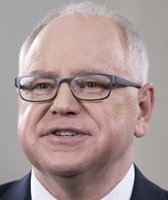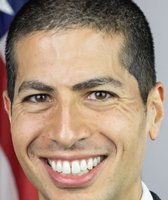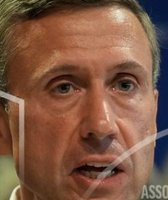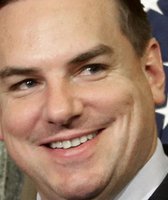Get PolitiFact in your inbox.
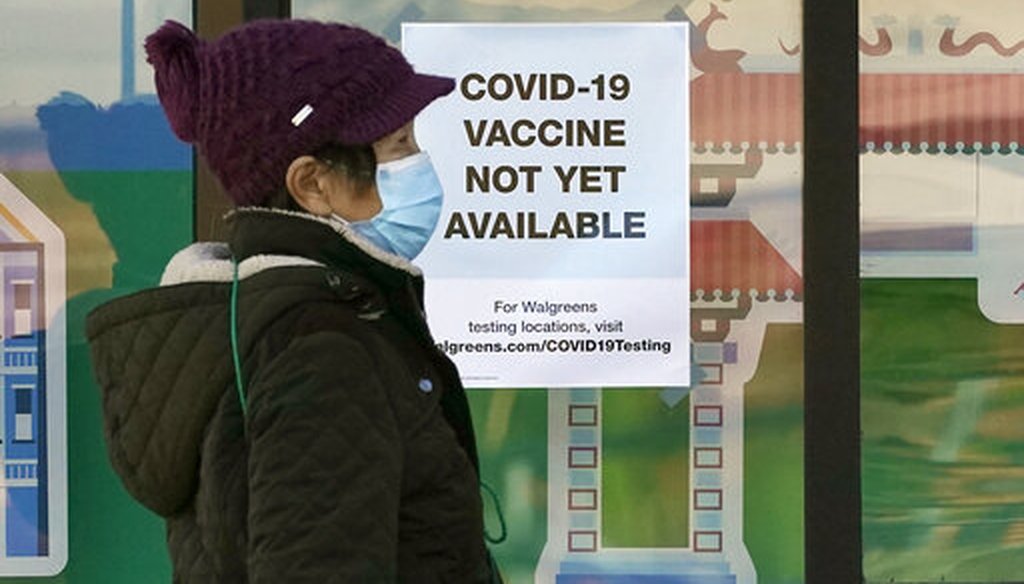
A pedestrian wearing a mask walks past a sign advising that COVID-19 vaccines are not available yet at a Walgreen's pharmacy store during the coronavirus outbreak in San Francisco, Wednesday, Dec. 2, 2020. (AP)
If Your Time is short
-
While the federal government is responsible for getting the vaccine distributed to the states, it has relied on the states to handle the distribution planning beyond that point.
-
States submitted plans to the federal government in October about vaccine distribution, but the plans lacked details such as the locations of future mass vaccine distribution sites.
-
Some factors are unknown, such as how much money the federal government will give states to implement mass distribution.
With the federal government poised to sign off on COVID-19 vaccines this month, President-elect Joe Biden said the nation has fallen short on its plan for distributing it to millions of Americans.
Asked by a reporter Dec. 4 whether he was satisfied with the Trump administration’s plans for vaccine distribution, Biden said much more work needs to happen.
"They’ve clued us into their planning on how they plan to distribute the actual vaccine to the various states," Biden said. "But there is no detailed plan, that we’ve seen anyway, as to how you get the vaccine out of a container, into an injection syringe into somebody’s arm. And it’s going to be very difficult for that to be done and it’s a very expensive proposition."
Biden’s transition team said that his statement wasn’t literally about taking a vaccine out of a container and injecting it into someone’s arm, but that he was trying to make a broader point that the federal government has fallen short on distribution planning.
In the same remarks, Biden identified challenges to vaccine distribution, including paying for it and getting the vaccine to communities of color that have been disproportionately affected by COVID-19.
"We have to have a much better way than we’ve seen thus far as to how it’s distributed," Biden said.
Biden said in August that the feds had no "game plan" to distribute the vaccine. We rated that Mostly True then. But given developments since then, we wondered if his current criticism about federal distribution planning is valid.
We found the federal government has taken steps to plan for distribution. However, a major part of the federal plan depends on states writing their own plans — and many of those blueprints remain works in progress, with additional details expected this month. What’s more, states don’t know how much federal funding they’ll get to implement these plans.
Federal officials defended vaccine distributing planning
Health and Human Services Secretary Alex Azar was unequivocal in rejecting Biden’s characterization of the vaccine plan. On Fox News Sunday Dec. 6, Azar called Biden’s statement "nonsense."
"We have comprehensive plans from the CDC working with 64 public health jurisdictions across the country, as our governors have laid out very detailed plans that we've worked with them on," Azar said. "We're leveraging our retail pharmacies, our hospitals, our public health departments, our community health centers."
Dr. Moncef Slaoui, who is leading the government’s effort to speed vaccine development, said on CNN’s State of the Union that there are distribution plans, but that federal officials hadn’t yet explained them to the Biden transition team. Operation Warp Speed officials held their first meeting with the Biden team in late November and plan to hold another one, possibly later in the week. Trump initially barred administration officials from cooperating with the transition team.
States submitted distribution plans in October
Operation Warp Speed has made some plans to place vaccines into kits with some supplies and shipped out, said Adriane Casalotti, chief of government and public affairs at the National Association of County and City Health Officials.
But planning beyond that — getting vaccines to the right people at the right time, making sure they come back for their second doses and keeping track of that information — is the responsibility of jurisdictions that get direct funding from the Centers for Disease Control and Prevention. That includes states, territories and a handful of large cities.
"There is no one national plan about all of these steps," Casalotti said.
Federal officials have acknowledged that the states are in the driver’s seat in terms of handling distribution.
"Our responsibility is to enable their plan, to empower their plan," Army Gen. Gustave Perna, chief operating officer of Operation Warp Speed, told reporters.
In September, the Trump administration announced a general strategy to distribute the vaccine, which included making it free of cost. The CDC gave states an interim playbook to help them create distribution plans, which they submitted in October.
These plans have general information but lack certain details. For example, Florida’s 51-page plan includes the names of officials on a vaccine working group; a list of expected priority groups, including health care workers, nursing home residents and first responders and how many people are in each category; and information about the state’s system for providers to log completed vaccinations. Florida’s plan includes no details about mass vaccination sites or how residents can sign up for the vaccine.
In a November review of states’ plans, ProPublica, a nonprofit investigative website, found that most states were not ready to distribute the vaccine. Among states’ challenges are hiring large numbers of contractors, storing the ultracold vaccines, delivering the vaccines to rural areas, and reaching out to certain groups, such as immigrants who are in the country illegally.
The U.S. Food and Drug Administration will hold a hearing Dec. 10 for the Pfizer vaccine and on Dec. 17 for the Moderna vaccine, and emergency use authorization could quickly follow. Federal officials project that doses will be distributed to vaccinate 20 million people in December and ramp up after that, with a plan to vaccinate 100 million people by the end of the first quarter in 2021.
A committee of vaccine advisers to the CDC recommended that the initial doses go to health care workers and people in nursing homes, although states can set their own priorities. About 36 states said they want the initial doses to go to long-term care facilities. It’s expected that states will vaccinate essential workers, the elderly and people with certain health conditions before the vaccine is offered to the general public.
Federal officials have said the general adult population should be able to get the vaccine by June, but it will likely take longer for children to get vaccinated.
The initial vaccination effort, largely in hospitals and nursing homes, may turn out to be less logistically complex than later efforts to vaccinate the general public. Mass vaccination clinics will involve additional workers, large spaces with room for social distancing and public messaging campaigns, plus any unforeseeable challenges. As Hawaii’s plan notes, quoting Mike Tyson: "Everyone has a plan until you get punched in the mouth."
Federal funding — a big unknown — limits states’ planning
One big unknown for the states is how much money the federal government will give them for vaccine distribution.
Congress approved the CARES Act in March, which included $340 million for flu and COVID-19 vaccine planning. The CDC plans to distribute another $140 million in December. But Congress has stalled in its efforts to approve more distribution funding.
CDC Director Robert Redfield told a Senate panel in September that states would need $6 billion to distribute the vaccine, while associations that represent state health officials put the figure at $8.4 billion.
Biden said Dec. 8 that without urgent action in December by Congress to provide distribution money, "there is a real chance that, after an early round of vaccinations, the effort will slow and stall."
Uncertainty over funding seems to be hampering states’ ability to strategize. Virginia’s plan updated in November, states that it received $22 million through the CARES Act. But the state’s "preparedness gap analysis" estimated it will need about $71 million to support local health agencies to establish and operate mass vaccination clinics, including the hiring of temporary workers.
The vaccine planning comes as underfunded public health agencies are already swamped with handling COVID-19 testing sites, contact tracing and other tasks.
RELATED: Many Americans say they don’t want a vaccine. Should we be worried?
Our Sources
Rev.com, Transcript of President Elect Joe Biden, Dec. 4, 2020
Rev.com, HHS Briefing on Operation Warp Speed, Vaccine Distribution Transcript, Dec. 2, 2020
Association of State and Territorial Health Officials and Association of Immunization Managers, Letter to Congressional leaders, Oct. 15, 2020
CNN State of the Union, Transcript, and Dec. 6, 2020
ProPublica, Most States Aren’t Ready to Distribute the Leading COVID-19 Vaccine, Nov. 10, 2020
USA Today, Getting a vaccine has been a huge undertaking. How all 50 states scramble to dole them out is the next massive challenge. Dec. 8, 2020
Politico, Trump officials hold first ‘Operation Warp Speed’ briefing for Biden, Nov. 25, 2020
Tampa Bay Times, Florida plans to ration first allocation of COVID-19 vaccine, Nov. 11, 2020
Kaiser Family Foundation, States Are Getting Ready to Distribute COVID-19 Vaccines. What Do Their Plans Tell Us So Far? Nov. 18, 2020
Milwaukee Journal Sentinel, Wisconsin expects to receive about 65,000 doses of Pfizer, Moderna COVID-19 vaccines in next two weeks, Dec. 7, 2020
NBC News, After first round of vaccine distributions, bulk of planning remains unfinished, Dec. 4, 2020
Bloomberg, Biden Introduces Health Team Led by Becerra, Covid Coordinators, Dec. 8, 2020
Briefing with senior officials on Operation Warp Speed and COVID-19 Vaccines, Dec. 9, 2020
PolitiFact, Fact-checking Joe Biden on a coronavirus vaccine, Sept. 17, 2020
PolitiFact, Joe Biden said there is no 'game plan' to distribute coronavirus vaccine. Is he right? Aug. 11, 2020
Email interview, Kelly Moore, associate director for immunization education, Immunization Action Coalition, Dec. 7, 2020
Email interview, TJ Ducklo, spokesperson for president elect Joe Biden, Dec. 7, 2020
Email interview, Natalie Baldassarre, spokesperson for U.S. Department of Health and Human Services, Dec. 7, 2020
Telephone interview, Adriane Casalotti, chief of government and public affairs at the National Association of County and City Health Officials, Dec. 8, 2020
Email interview, James Garrow, a spokesperson for the Philadelphia Department of Public Health, Dec. 8, 2020


